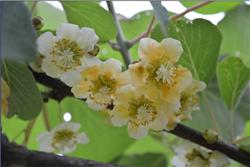Cutting Seedling of improved varieties of Actinidia
In order to prepare the cutting seedbed, the dry soil with high topography, loose soil and certain water retention capacity should be selected. After ploughing, the land was arranged into a seedbed about 1 meter wide and 25 centimeters high, mixed with a certain amount of river sand on the bed surface, and disinfected the soil twice with 1% 0.5% potassium permanganate. Before and after the middle and late June, the semi-lignified branches of the same year were selected and cut into 2-3 segments of cuttings. Cut flat about 1-2 cm from the upper end bud, leaving 1 or 1 beat 2 leaves, the lower end is close to the inferior node shear oblique. Soak the base of cuttings with indolebutyric acid or naphthylacetic acid of 2000ppm~5000ppm for 3 hours and insert them into the seedbed according to the row spacing of 10 × 15 cm. After cutting, the soil around the cuttings is pressed and watered again. Hardwood cuttings are usually carried out from defoliation to dormancy and before injury in December to March of the following year. Select the lignified branches with strong growth and stem diameter of 0.4 cm to 0.8 cm and cut them into cuttings with 2 buds. The upper and lower cut should be smooth. The upper cut should be cut 1 cm away from the bud and sealed with wax after cutting. After soaking the base in the indole butyric acid solution of 5000ppm for 5 minutes, it can be inserted into the seedbed. After the management of cuttings, attention should be paid to building a shade shed to protect water, sun, rain and wind, and control the light in the bed. When the new shoot grows to 5 cm, leave 3 or 4 leaves to pick the heart at the right time to control the growth of the aboveground part and promote the root to form seedlings. After the seedlings grow to 10-15 cm, grass control and fertilization will be strengthened gradually.
- Prev

Key points of kiwifruit management in early spring
Early prevention of diseases and insect pests before germination and germination stage, 100-150 times of barium sulfide for tree insect control or 3 to 5 degrees of stone-sulfur mixture to kill eggs and overwintering bacteria. The early application of budding fertilizer was 1.5 kg per tree for big trees and 0.5 jin for young trees. Set up the pillar early and tie it up as soon as possible.
- Next

Key points of post-anthesis management of kiwifruit
Forty days after kiwifruit blossoms, it is a critical period for kiwifruit management. The fruit expands rapidly and requires a lot of nutrients and water. First, fertilization after falling flowers, in mid-May, timely application of urea, diammonium, potassium chloride or ternary compound fertilizer, fertilizer application amount of urea 20 kg per mu, diammonium 15 kg, chlorination.
Related
- Moge, come on! The staff of the peasant association in the producing area of cantaloupe were frightened when the crowd gathered.
- Causes and Solutions of low Fruit setting rate of Apple
- Symptoms and control measures of passion fruit virus disease
- Fruit growing lesson: how do apple orchards keep high yields?
- Can you build orchards in the mountains? What are the pros and cons?
- How to manage the coloring period of Crisson grape?
- This paper introduces the processing technology of two kinds of fig products.
- How much is a month for retired teachers in rural areas by 2020?
- How can strawberry planting increase sugar content? We should pay attention to management in many aspects.
- What are the cultivation techniques on how to improve the yield of golden fruit?

